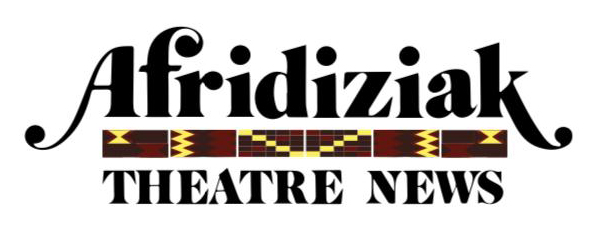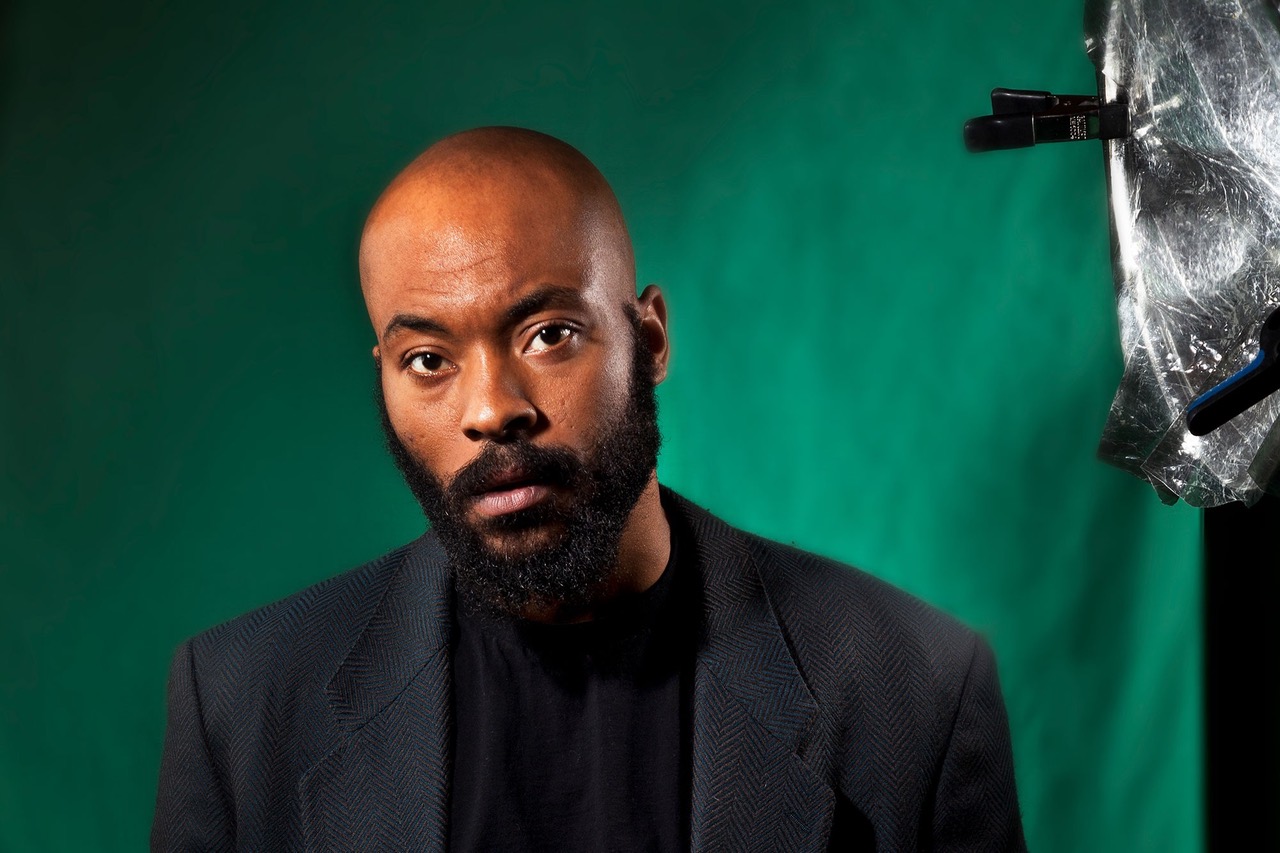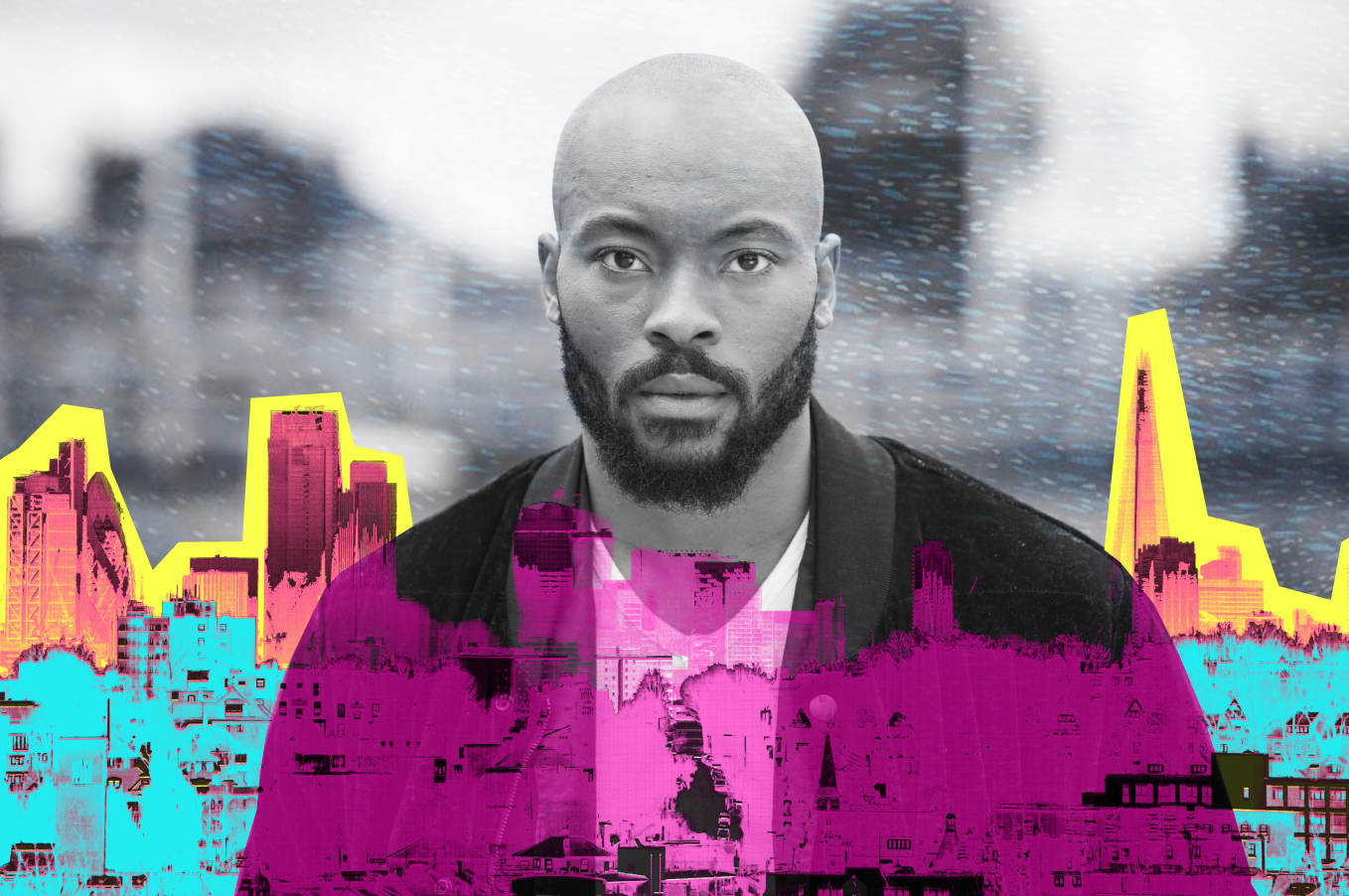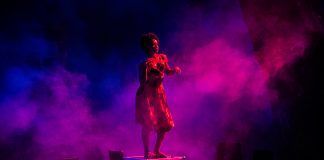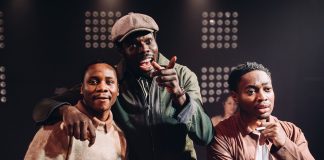If I were attempting to write this review in the style of Arinzé Kene’s extraordinarily rich and ambitious piece, it would have to include several longueurs, a volte-face (or several), a few quotes/voice-overs from a couple of Hollywood ‘A-listers’, and a mighty central performance that is almost certainly beyond me; so I won’t bother going down that particular road!
At the beginning, “The performer” – Arinzé Kene, himself – is flanked either side, by a drummer, and a soundscape artist/keyboard player. He starts to describe the London urban landscape as a “living creature”; the boroughs as “organs”; motorways as “arteries”; high streets as “arterioles”; roads as “capillaries”; good citizens as ‘red or white blood cells’; bad citizens as “viruses”, and the police as “anti-viruses”.
Supported by a back-projection – showing a moving urban nightscape – and a sparse, yet evocative live soundscape, the narrator weaves a spoken-word tour-de-force of ‘night-bus angst’, (Black) rage, and violence in the urban inner cities.
So far-so-Stormzy / Lamar (!)
Entertaining, but nothing we haven’t seen (or heard) before, right? But wait…
Arinzé Kene gives a performance of great cerebral, emotional and physical intensity.
Once the aural and verbal storm subsides, we get a very different narrative – one that raises questions about the role of a ‘black writer’ in contemporary Britain.
One of these is whether or not a ‘black writer’ is the same as a ‘writer who is black’, or – indeed – whether a ‘black writer’ can be merely ‘a writer of black issues’.
Furthermore, if the writer happens to be of Black origin, does this mean that they have an obligation to tell ‘the truth’ – even if said ‘truth’ reinforces certain negative stereotypes and/or presents the harsh realities of some Black people’s lives?
Indeed, by obscuring the truth, in order to present the black diaspora in a light that is more palatable (as Hollywood does for the wider/Whiter Community), is the writer offering ‘light at the end of the tunnel’, or just making that tunnel longer?
In a world-spanning, free-ranging ‘black diaspora’, whose truth is most valid?
And, as the playwright/performer himself says: “black lies matter too.”
Through a series of clever – and funny – skits and theatrical tricks, we get to see and hear different points of view on the role of the black writer:
The two musicians appear behind the gauze, to become “Raymond” and “Donna”, two friends who – via voice notes – kind-heartedly accuse The Performer/ Playwright of ‘selling out’, and writing ‘just another nigga play’ – a ‘modern minstrel show’.
Similarly, a little girl (about ten years old) enacts an email, written by The Playwright’s older sister, warning him that he had better not be writing any “hot buffoonery to pander to the voyeuristic needs of the bourgeoisie” (!)
Inventive and incendiary.
And then, after the interval, the piece makes another shift; letting us know who the real ‘viruses’ might be.
It’s audacious in its set-up, and its lack of ‘let-up’.
It also requires a huge amount of verbal, and physical, dexterity from Kene.
He sings; he rages; he patrols the stage; he blows up balloons (!) At one stage, we even see him wriggling out of a most uncomfortable position – all while wrestling with his conscience, community, and his muse.
one of the most challenging and vital pieces of social theatre I’ve seen in a long time
This is not just a ‘meta-piece’ about the writing process, in the spirit of countless movies from the likes of Woody Allen or Charlie Kaufman; this is a serious exploration of the pressures placed on a ‘commissioned black writer’.
In a culture where black (his) stories are routinely ignored or marginalised, there is more pressure on those black creators, who happen to gain the attention of the gatekeepers, to ‘represent’.
But represent whom – or what? And how? And how often?
These questions are acknowledged – if not answered – with wit, and style.
I’ll be honest – on a couple of occasions, I found myself wondering, despite the quality – and quantity – of inventive theatre on display, why I wasn’t feeling deeply emotionally invested in the proceedings. Where were ‘the stakes’?
Then I realised that ‘the stakes’ can’t get much higher for an individual black ‘creative’ [and if we’re surviving in a Western, urban environment, aren’t we all being creative?] than to strive for individual and cultural authenticity – in public.
Omar Elerian’s direction is tight and clear-sighted, without being stifling.
The staging by Rajha Shakiry is both gorgeous and practical: the framing by the two musicians, the use of projection, back spacing, and ‘the box’…all excellent.
Daniel Denton and Jackie Shemesh also deserve ‘shout outs’ for, respectively, video design and lighting.
This is a serious exploration of the pressures placed on a ‘commissioned black writer
Occasionally, I found myself wanting more volume from the spoken-word sections, but – for the most part – Elena Peña’s sound is excellent.
Of course, the music works well – in seeming to have been created in conjunction with the spoken-word sections, rather than as an addendum. Not just underpinning what’s already there, the interplay between the reggae / hip-hop-style electronic drum / keyboard soundscapes work hand-in-hand with the wordplay.
Dual-MDs, Shiloh Coke (drums/bass) and Adrian McLeod (keys) certainly deserve plaudits for their musicianship, as well as their funny delivery when acting.
But it’s to writer/performer Arinzé Kene to whom the most plaudits must go. His is a performance of great cerebral, emotional and physical intensity. The fact that he makes it look so organic is a testament to his skill and stamina, as both a writer and performer.
This piece may not be the most ‘purely enjoyable’ time in the theatre I’ve ever had, but it is certainly one of the most challenging and vital pieces of social theatre I’ve seen in a long time.
